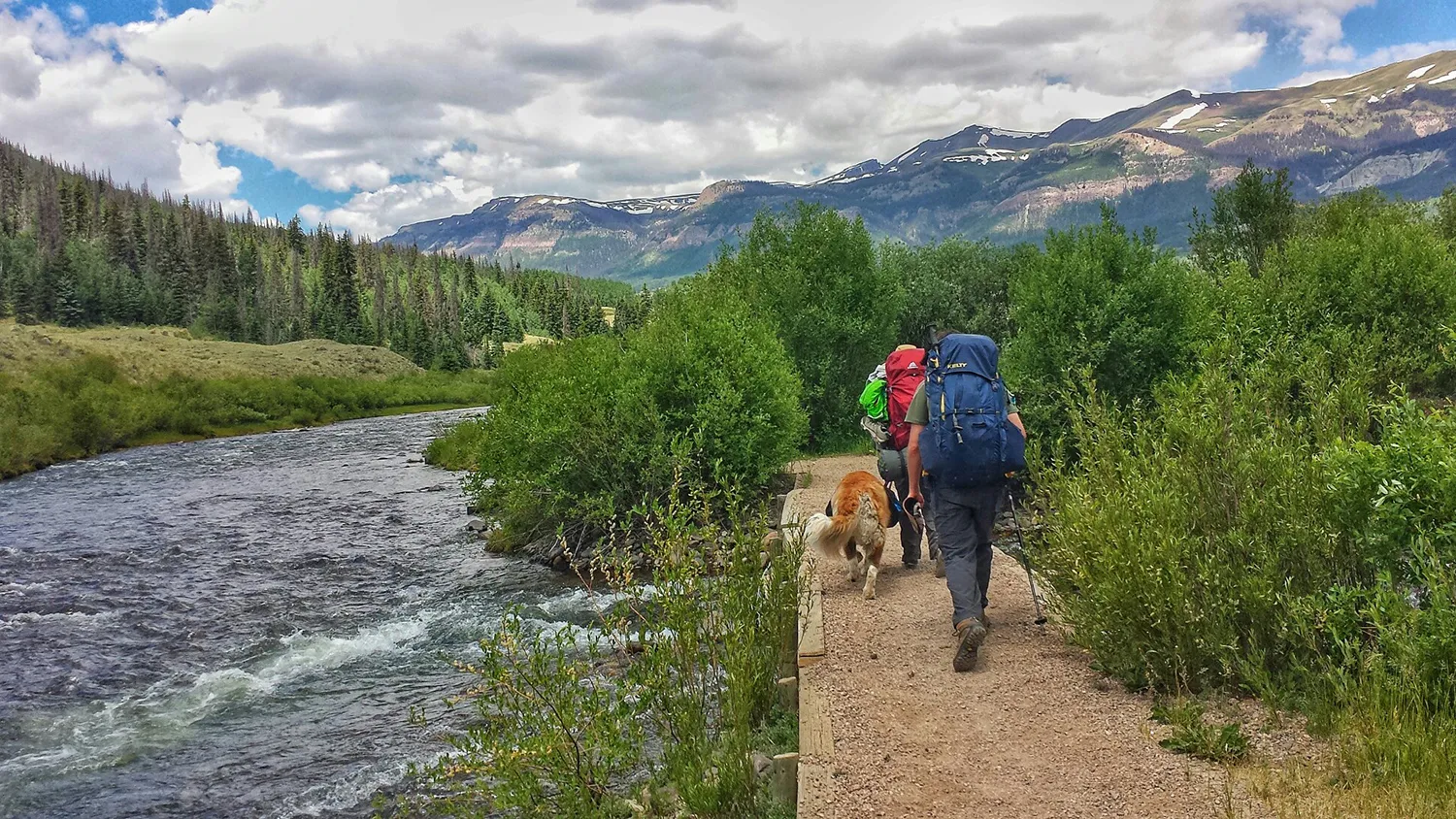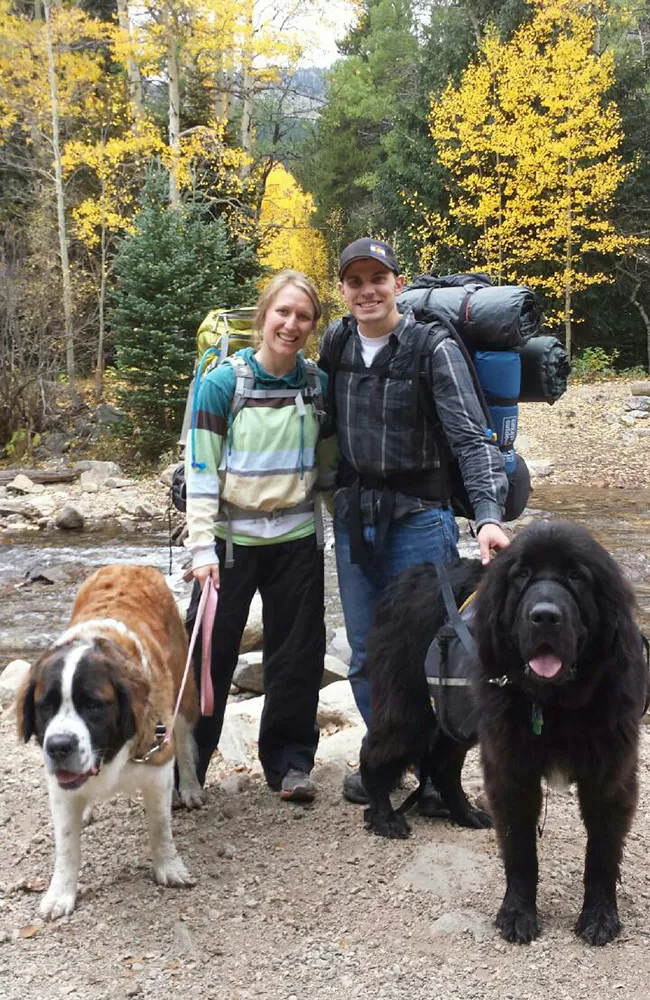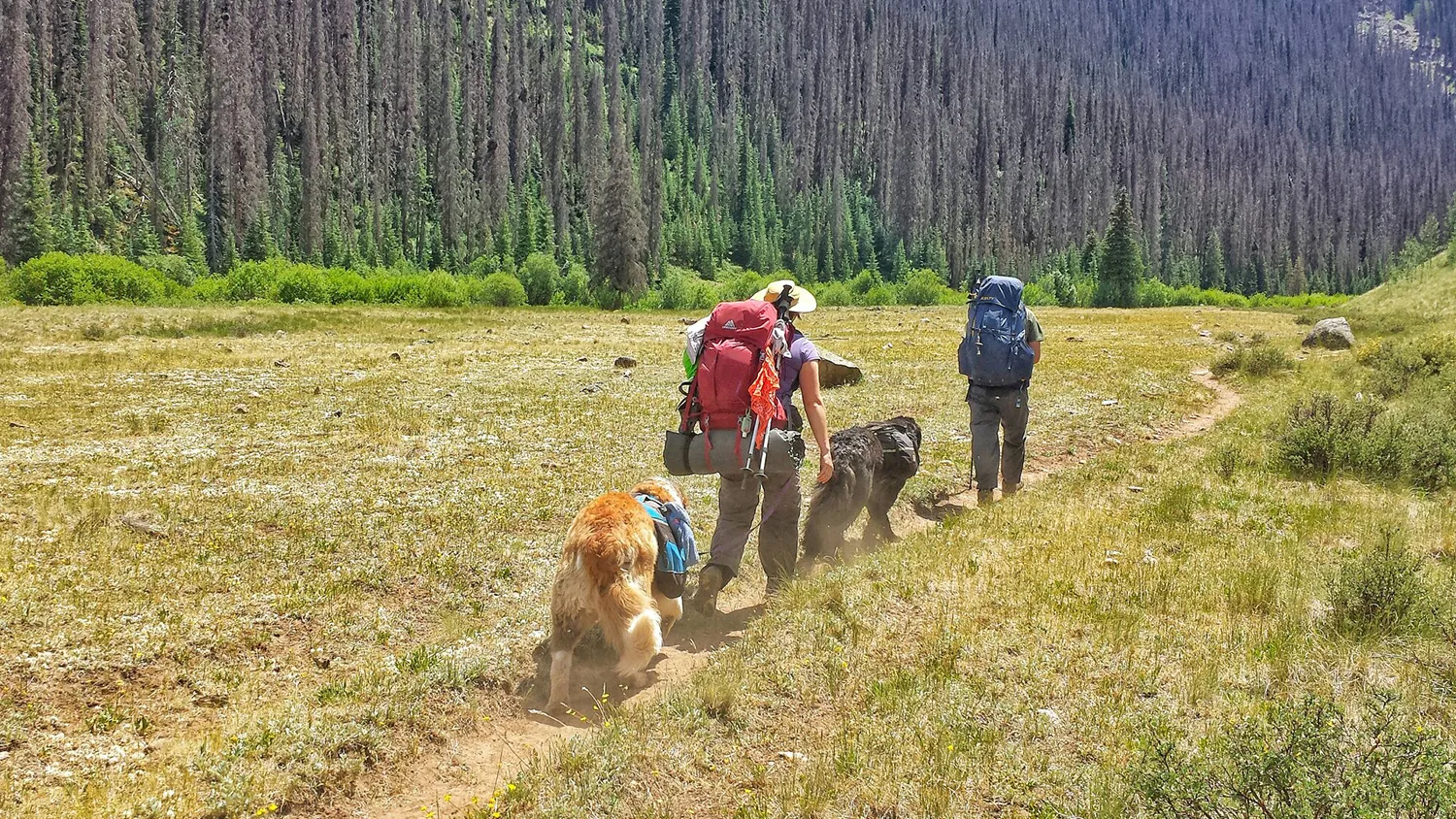On a crisp Friday morning, I found myself winding my way up a solid dirt path, my faithful Saint Bernard, Bailey, by my side. We were en route to Herman Gulch, a stunning and popular lake destination for hikers in Colorado. The path was lined with tall evergreens, and the crystal-clear river provided a pleasant soundtrack to our ascent. After hiking 3.5 miles uphill, we reached the ridge. My hiking boots crunched through remnants of snow patches, and Bailey happily gulped down snow, chomping at the tiny pieces of ice. Cresting the ridge, we gazed upon the sparkling lake below, cradled in a natural bowl surrounded by jagged mountain peaks. We stopped to take it all in, enjoying a moment of perfect serenity.
Moments later, my peaceful experience was rudely interrupted by a medium-sized Labrador bounding up from the lake, barking obnoxiously. Predictably, the owners jumped to attention, shouting, “Hey, get back here! Come, Scout, Come!” If there was any wildlife present, it had surely scattered by this time. Bounding in full force, the dog reached us and launched his front paws onto my stomach, leaving streaks of mud across my shirt. The owners came trampling up the hill, took their dog by the collar, and shamefully avoided eye contact as they directed him back to their once-peaceful spot by the lake.
This scenario, unfortunately, is not unique. Many hikers have experienced similar situations, or perhaps you’ve been that owner who watched your dog commit to a decision that left you feeling helpless and mildly humiliated. As avid hikers, many of us strive to abide by the Leave No Trace Principles to minimize our impact on the outdoors. For humans, these principles are well-defined: stay on the trail, pack out trash, leave nature as it is, and respect wildlife. But is it possible to train our dogs to do the same, particularly when we aspire to hike without a leash? Most definitely! This article will guide you through the essential training to achieve reliable off-leash behavior, allowing your dog to “leave only pawprints” while ensuring safety and respect for the environment. Achieving this level of discipline can even translate into skills useful for more specialized roles, such as learning how to train your dog to be a service dog.
Foundational Leash Skills: The Path to Off-Leash Reliability
The conversation about leashes often sparks debate among hikers who prefer their dogs to roam free. While the ultimate goal might be to train your dog to hike without a leash, mastering polite leash walking is a critical foundational step. The truth is, a dog that hikes calmly on a leash inherently leaves less trace, making minimal impact on vegetation and wildlife. Many owners confess their dogs are “better off-leash than on,” which often indicates a lack of successful leash training. If your dog hasn’t yet mastered walking politely on a loose leash, here are the basics to build that crucial control.
Using a standard 6-foot nylon leash is highly recommended. This length provides consistent and reliable control, keeping your dog safely on the trail and minimizing disruption. Retractable leashes, while seemingly convenient, are too inconsistent for training and can be dangerous if your dog suddenly bolts after wildlife. For dogs that pull, a front-hook harness is an excellent choice, as it makes it anatomically awkward for them to pull forward. For persistent strong pullers, a head halter designed to loop comfortably around the snout offers ultimate control over their momentum. Remember, you’ll need to help your dog get used to wearing any new equipment before hitting the trail. While a leash may not always be your preference, it is the most effective way to minimize your dog’s impact and build the disciplined habits necessary for eventual off-leash freedom. When your dog walks nicely alongside you, you’ll barely notice the leash at all, making it a comfortable experience for both of you.
 A Saint Bernard dog walking off-leash on a mountain trail with evergreen trees
A Saint Bernard dog walking off-leash on a mountain trail with evergreen trees
Command Excellence: “Come When Called” for Off-Leash Safety
If you’re hiking on a trail where off-leash dogs are permitted, it is paramount that your dog is absolutely fluent in the “come” command. This isn’t just a convenience; it’s a serious, life-saving skill. Your dog needs to be conditioned to bolt back to your side instantly whenever they hear “come.” The most effective way to instill this rapid response is to consistently pair the word “COME” with an ultimate, high-value treat – think bacon, hot dogs, cheese, pork fat, or leftover steak. The goal is for your dog to develop a subconscious response of excitement, convinced that this special word always brings an irresistible reward. This unwavering recall is also a key component of foundational training, similar to the obedience required to train your dog like a service dog.
Begin this vital training in a distraction-free environment at home. Say “COME” once and immediately deliver the ultimate treat directly to your dog’s mouth. Take one step back and repeat. Gradually increase the distance – two steps, then three, four, and so on – until your dog anticipates your call and stays close. Once your dog grasps this, enlist a partner for what’s known as the recall game. Stand about 5 feet apart. One person calls the dog by name, then clearly says “COME” once. When the dog reaches them, lavish praise and offer several tiny bits of the high-value food reward. Then, the other person repeats the process. Continuously call your dog back and forth, slowly increasing the distance until your dog will enthusiastically run to you from any distance.
Crucially, once your dog has developed a quick response to “COME,” reward them every single time they respond. This isn’t a sometimes thing; it’s an every time guarantee. This consistent positive reinforcement is the only surefire way to ensure the command works reliably amidst the myriad distractions of a hiking trail. Therefore, always bring a high-value food reward with you when hiking. Freeze-dried lamb, liver, or venison are excellent options because they are lightweight, don’t require refrigeration, and dogs absolutely love them. These treats are readily available at most pet stores and are essential for maintaining a strong recall, which is a core skill whether you want to teach them simple commands or even how to train your puppy to be a service dog.
 A Golden Retriever dog running playfully on a rocky trail towards a mountain lake
A Golden Retriever dog running playfully on a rocky trail towards a mountain lake
Managing Vocalization: Teach Your Dog to Speak Sparingly on the Trail
Barking is a natural dog behavior, but excessive barking in the wilderness can disturb not only other hikers but also have a significant undesirable impact on wildlife. Understanding how to manage your dog’s vocalizations is a key component of training your dog to not use a leash responsibly. Let’s address two common barking scenarios hikers encounter.
First, imagine you’re hiking on-leash, and another hiker with a dog approaches. Your dog might bark out of excitement, anxiety, or fear. Regardless of the underlying reason, this behavior needs redirection. Get your dog’s attention and reward them with treats for focusing on you. If you can multitask, continue walking while frequently rewarding your dog for maintaining focus. Alternatively, step off the trail, taking care not to trample vegetation, and ask your dog to sit. Continue to reward them with treats as the other dog passes, keeping your dog’s attention on you. Consistent practice is vital for your dog to learn to focus on you rather than passing people or dogs. However, if an off-leash dog is running directly towards you, the training opportunity is often lost, and it might be best to allow a brief, controlled greeting before continuing on your way.
Many dogs also tend to react vocally after resting in one spot for a while. For instance, you’re enjoying a snack by an alpine lake, your dog is quietly by your side, and a person crests the hill into view. Your dog perks up, starts barking, and perhaps even runs toward the unsuspecting hiker. This is frustrating for the owner and can be incredibly annoying for the passing person. In this scenario, ensure your dog is leashed when you rest and provide a long-lasting chew item like a bully stick, large rawhide, Himalayan yak stick, or elk antler. This will help keep your dog happy, engaged, and quiet as other hikers pass, promoting a peaceful environment for everyone. If your dog frequently barks at visual triggers while on a leash, this is known as “leash reactivity.” If your dog consistently struggles with this, consider enrolling in personalized training for hands-on assistance to resolve this behavior off the trail. The goal isn’t to say “no” but to redirect their behavior toward more appropriate choices, building their skills for focused attention – a trait highly valued if you ever consider how to train your dog as a service dog.
 A dog sitting calmly on a leash next to its owner on a hiking trail
A dog sitting calmly on a leash next to its owner on a hiking trail
Canine Carry-All: The Benefits of Your Dog Packing Its Own Gear
Part of responsible hiking, whether with or without a leash, involves being prepared. Most furry hiking companions are perfectly capable of carrying their own hiking supplies! However, don’t strap a brand-new pack on your dog’s back for the first time at the trailhead. While some dogs might tolerate it, it’s highly recommended to get your dog accustomed to wearing a pack before hitting the trails. Here’s how to introduce it effectively:
Once you’ve found an appropriate pack for your dog, put the empty pack on them just before mealtime. Let your dog eat their meal with the pack on, then remove it. This simple method desensitizes your dog to the pack, creating a positive association. After a few days of this routine, have your dog wear the empty pack on daily neighborhood walks. Once they seem comfortable, gradually start adding some weight. Generally, dogs can safely carry 15-20% of their body weight. By following this process, most dogs will be comfortable wearing a pack within 5-7 days, if not sooner.
You might wonder why your dog needs to wear a pack. While not strictly essential, throughout this guide, we’ve mentioned specific items crucial for training and responsible hiking, including high-value treats, chew items, and harnesses. It’s also vital to bring a collapsible water bowl, poop bags, and dog first aid supplies. Dogs were bred to work, so giving your dog a job by having them carry their own supplies can be incredibly beneficial for their mental well-being and sense of purpose. Not to mention, it’s incredibly handy for packing out that used poop bag, further aligning with Leave No Trace principles. This self-sufficiency can be a valuable step, reinforcing the discipline needed for more advanced objectives like how to train your own service dog for anxiety.
 A dog drinking water from a collapsible bowl on a hiking trail
A dog drinking water from a collapsible bowl on a hiking trail
Overcoming Training Challenges and Seeking Expert Help
It’s important to remember that every dog is an individual, and different breeds have unique needs and learning curves. If you find yourself becoming frustrated with training your dog to hike reliably without a leash, keep these crucial points in mind:
- Start in Low-Distraction Environments: Always practice new behaviors in calm, controlled settings before expecting them to work flawlessly on a bustling trail. If your dog doesn’t respond to “come” in your living room, it’s unrealistic to expect it to work in marmot-country. Dedicate time to regular practice at home, and you’ll see far greater success on your hiking adventures.
- Focus on Positive Reinforcement: While it’s important to teach your dog what not to do, it’s even more critical to teach them what they are supposed to do. Use a high-value food reward to keep your dog motivated. Food isn’t a bribe; it’s a powerful form of positive feedback for an animal that doesn’t speak English. If your dog is in training, never leave home without their favorite form of positive reinforcement.
- Don’t Hesitate to Hire a Professional Trainer: When in doubt or facing persistent challenges, consider hiring a professional trainer. Look for someone who emphasizes positive reinforcement and has several years of legitimate experience in animal training. They can provide personalized, tailored advice specifically for you and your dog’s needs, helping you achieve your goals, whether it’s off-leash hiking or even specific tasks like training a service dog for anxiety.
Remember, effective dog training, especially for advanced skills like hiking without a leash, requires time, patience, and unwavering consistency to achieve the desired results.
Conclusion
Training your dog to hike responsibly, even without a leash, is an achievable goal that enhances both your adventures and their well-being. By focusing on foundational leash skills, mastering the life-saving “come” command, teaching appropriate vocalization, and even empowering your dog to carry their own gear, you can cultivate a companion that respects the wilderness. Patience, consistent practice in varied environments, and a commitment to positive reinforcement are your most powerful tools. Embrace the journey, address challenges with understanding, and don’t shy away from professional guidance when needed. Use this comprehensive guide to help you and your furry friend embark on a successful and harmonious hiking journey, leaving nothing but pawprints behind.
Written by Jenn Fantasia. Jenn works seasonally for Colorado Parks and Wildlife in the Partnership Program, which forges relationships with outdoor organizations across the state in an effort to conserve Colorado’s natural resources. Jenn is also a professional dog trainer in Denver, Colorado.
